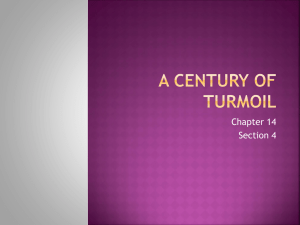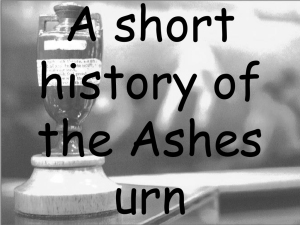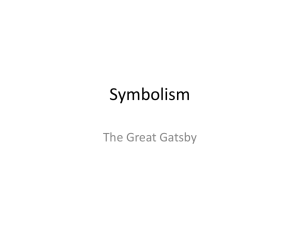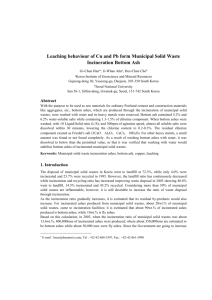Sw Ash Program - Svenska EnergiAskor AB
advertisement
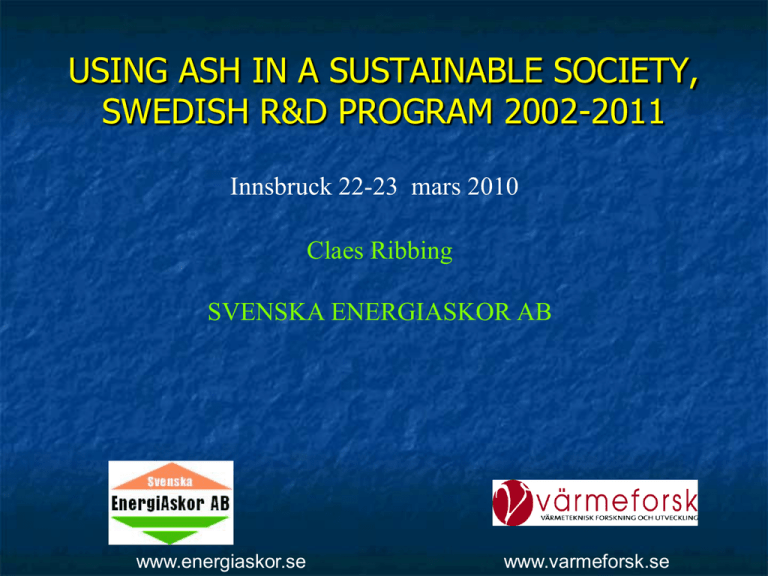
USING ASH IN A SUSTAINABLE SOCIETY, SWEDISH R&D PROGRAM 2002-2011 Innsbruck 22-23 mars 2010 Claes Ribbing SVENSKA ENERGIASKOR AB www.energiaskor.se www.varmeforsk.se The Vision of the Ash Program Combustion residues are resources in a sustainable society Research program Environmentally friendly uses of none coal ashes 1 m€/year since 2002. 40 companies and authorities The Thermal Enginiering Research Institute of Sweden Forestry Environment Geotechnigue Land filling. • Recycling • Criteria's • Roads • Dense layers •When outtake of energy • Expound laws • Surfaces • Stabilization • Extra Growth • Test methods • Concrete • Quality control • Mining • Covering Mine Tailings 3 Results The results are the results from the scientists. The Authorities don't automatically agree Specially not about the balance between The AIM of None toxic Nature Using wastes as resources Ash content in different fuels The Ash Program works with all their ashes 25% in municipal wastes Municipal waste contains up to 85% of bioenergi - but is not a subject for this presentation 5% in peat (can be much more) 10-50% in sludge from paper industry 2-4% in bark, needles and branches 0,2-0,5% in pure wood Claes Ribbing, Svenska EnergiAskor AB 5 Boilers (the Pictures show rebuilt boilers at Söderenergi) Powder cumbustion Peat, pellets (coal) ≈ 1 200 °C Fly ashes dominate Grate boiler Incinerators and Smaller boilers less than 100 MW All fuels as bark, wood chips industrial+ household Wastes etc 1 100 °C Bottom ashes dominate Fluidised bed. All fuels as wood chips, peat, wastes ≈ 850 °C Often equal amount fly/bottom ashes low NOx 6 Use of ashes in Sweden 2006 Problem: Many small producers Roads etc Forestry, Arable land Backfillning to cavities Construction on landfills Others, unknown Total Production 200 kton 35 kton 50 kton (APC) 650 kton 175 kton 1 milj ton 1,3 milj ton T Construction on landfills will more or less disappear within 10-15 years Ashes to forests A Cd ion from a rottening branch is not better than the same ion from returned ash Outtake of bio energy (branches and tops) demands recycling of ashes =(basic) minerals to get a sustainable forestry. The ash must be matured before spreading not to “burn” the ground It is rather costly Ashes and growth of forests In most of Sweden Nitrogen limits the rate of growth of trees at rich forest soils, ashes increases the release of in soil bound N which increases the growth Ditched peat soils need the minerals of ashes to get a good growth. When the deposition of N is high, Phosphorus is the limit for growth P budget for different harvesting scenarios for forests in Sweden No harvesting Stem harvesting Whole-tree harvesting (Akselsson et al., 2008) Conclusion When you take out both the stem and bio energy in form of tops and branches you have to return the ashes to get a sustainable forestry Otherwise in the long run P and other elements will be deficient. (not only in Sweden?) Nordic innovation centre report TR 613 2008 A report most of you should intereted in GUIDELINE FOR CLASSIFICATION OF ASH FROM SOLID BIOFUELS AND PEAT UTILISED FOR RECYCLING AND FERTILIZING IN FORESTRY AND AGRICULTURE info@nordicinnovation.net www.nordicinnovation.net Dense layers 50/50 of fly ashes and digested sewage sludges (dry wt) when closure of landfills It is dense: <10-9m/s It has an OK shear strength >30kPa It stands settlements It is long lasting: the biological and chemical degrading are very, very slow (High pH, Salts, Low perculation) Dense layer trails at Dragmossen Claes Ribbing, Svenska EnergiAskor AB 13 The Tveta method After a lot of research work At the Tveta Landfill they use wastes and specially ashes in all layers Layer composition for the landfill cover system Bio/waste ashes in concrete In concrete, bio fly ashes are good fillers and can replace a lot of Portland cement Clorides (0,1% Cl in the paste) are a problem, they corrode the armouring-iron. Low quality concretes are preferred markets. 16 Bio fly ashes in roads in the sublevels Stiffer and stronger roads Stabilizes bad/old materials Less material! 1/4! Much better frost heave resistant Less maintenance No measured impact on environment Light weight construction Constructions with fly ashes This plant for recycling of domestic wastes – is a light weight construction of wood/peat fly ash on clay soil Ports must be dreged Stabilizing dredged material is an interesting market possibility for different fly ashes. (photo OY Ramboll). . 18 Constructions with bottom ashes Grate boiler bottom ashes are good road building materials Even if the test results on water upptake are high Better the more sintered the ash is. Powder bottom ashes are often poorer due too high amount of unburnt. Fluid bed bottom ashes are too fine or too narrow sized to 19 be good. Test methods Normal test methods don't suite and don't give justice to weak materials Bottom ashes shall be tested with functional test methods as the dynamic triaxial method . Modelling of Low Risk to health and environment 1/100 000 risk to get damaged To get cancer (not to die of it) For one individual in the most exposed group That leads to very improbable and conservative scenarios. Shall not increase the the amount of undesired impurities above normal variations in the recipient Shall not contaminate the groundwater as to the TACmodel for landfills The critical scenario for low risk using Ashes as 0,5m thick sublevel in roads without other restrictions Dust on vegetables are more critical than leaching! Scenario: 1/3 of his yearly intake of Vegetables. He hardly washes them. Dust from Building the road + maintenance and demolition 20m For gravel roads are calculated that ash is not used in the surface layer but some ash reaches the surface through maintenance. Moderate traffic creates dust during 64 years and 5% of the dust is ash. Modelling gives: Is a low risk for using bioashes i sublevels! Max contents Pb Cd Hg Zn As Free use due to Sw EPA No risk 20 0,2 0,1 120 10 Ashes to forests due to Swedish Forests Agency 300 30 3 7 000 30 Low local risk gravel roads 1 400 330 80 >2,5 % 55 Low risk leaving ashes at the surface exposure 40 dusty days/y 1 500 60 60 > 5% 15 Uses shall be given priority when the risk for health and environment is low Modelling and tests give that most ashes can be used as resources in a sustainable society Thanks for your attention claes.ribbing@energiaskor.se you are welcomed to mail me This presentation will be published at www.energiaskor.se The synthesises of the Ash Programme 2002-2008 (report 1111) and the database ALLASKA are published in English at www.varmeforsk.se Don´t forget TR 613 www.nordicinnovation.net

